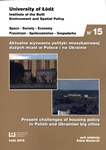Tereny mieszkaniowe w krajobrazie Lwowa (w drugiej połowie XX i na początku XXI wieku)
RESIDENTIAL AREAS IN TOWNSCAPE OF LVIV (IN THE SECOND HALF OF 20TH – AT THE BEGINNING OF 21TH)
Author(s): BOHDAN PosatskyySubject(s): Rural and urban sociology
Published by: Wydawnictwo Uniwersytetu Łódzkiego
Keywords: Lviv; residential area; dwelling house; city space; townscape
Summary/Abstract: Residential areas to a great extend shape the landscape of Lviv. According to the general trend of the concentric city development, residential areas of the second half of the twentieth century surrounded in the form of a ring the city territory at the XIV – early XX century.Their spatial forms varied depending on the trends that prevailed in architecture and urban planning in USSR and then in U kraine: – 1945–1955, imitation of classical architecture and urbanism forms; – 1956–1990, application of the functionalism principles, construction of the city periphery, large-scale compositions of residential areas; – 1991 – up till now, the plurality of spatial forms, construction of individual building-seals, small residential neighborhoods.Radical real changes in Lviv townscape commenced in the end of 1950s. Since that time the dynamic development of the town began, and facilitated towns transformation into the largest industrial centre in eastern Ukraine. First new dwelling sites emerged in 1950–1960s in the western sector of the town.In 1970–1980’s housing appeared on vast territories of the southern, northern and eastern sectors of the town. The new industrial and dwelling districts gained quite a new (much more larger than previous one) spatial scale of urban management and housing of the territory, determined by theory of the Soviet urban planning of that time. The territory planning presupposed the very change of the urban form, traditional blocks were altered by „free” located separate buildings on the territory.Dwelling housing, at first, consisted of 5–9-storey buildings. In 1970s and during the 1980s the height of houses was risen to 12–15-floors. Thus, large dwelling sites with great number of multistorey buildings were formed. The compact town housing of the first half of 20th century was changed by the new image of urban areas, that consisted a „separately located” edifices with vast spaces between them (yet the young trees were not high). Two, almost independent, town scapes emerged coegsisting on the town’s territory: historical and contemporary townscapes (i.e. of the second half of the 20th c.). Luckily the relief of the site allows to separate visually historical and contemporary town landscapes: historical town is situated in the amphiteatre of the Poltva river valley, and the new residential areas occupy the eminence of the plateau around the valley.|The peculiar example of the new town landscape construction is Syhiv residential site (district) in the southern sector of the town, being constructed during the last two decades. Housing of this area got started in 1980s, and during the first several years consisted of groups of 9-storey buildings of the same type, located almost regularly on the territory. This esidential territory occupies an area of 300 hectares between Zelena and Stryjska streets, former trade routes, stretching to the north-eastern and southern directions from Lviv.During the first decade the dwelling houses of Syhiv consisted of 9-storey large panel construction apartment building, later on, after 1990s, requirements of a total typification were eliminated, and separate 12–15-storey houses of a tower-type gained monumentum; they were becoming spatial accents.By 1991, architectural image of Syhiv was replenished by houses of religious worship – churches and chapels. First, they were built-up spontaneously, almost without architects. The largest new church in Lviv was constructed in the district centre of Syhiv after the design of Radoslav Zhuk, Ukrainian born Canadian architect. In the beginning of 1990s, the territorial development of the residential and industrial areas within the town was almost stopped instead, private single family house architecture in the suburban zone gained momentum, and in 1991–1997 a ring belt of two and three-storeyhouses, that embraced multistorey housing areas of 1960–1980s was created. Another change of the spatial scale of the housing of a territory took place, this time – by its sharp reduce.At the end of 1990s town landscape of the periphery zone of Lviv’s central part (at the border with the new dwelling quarters of multi-storey housing) was slightly changing. Construction of the 5–9-storey multi-compartment dwelling houses with flats equipped in and correspondence to contemporary European requirements was commenced in this zone. These houses were erected by private investors on separate free plots, mostly among extant 2–3-storey dwelling housing, that engirdled 3–4-storey dwelling quarters (dated to a cross of the 19–20th cc.) in the centre of the town. Due to their height the new constructions created local spatial emphasis. Peculiar feature of architectural image of these buildings is combination of forms of European Post-Modernism and regional Sub-Carpathian architecture. Houses posses slopping roofs, covered with roofings, facades are built of brick, covered with plaster, wood is applied as well as glass, metal and plastic material.Tereny mieszkaniowe w znacznej mierze kształtują krajobraz Lwowa. Zgodnie z ogólną tendencją koncentrycznego rozwoju miasta tereny mieszkaniowe drugiej połowy XX w. otoczyły pierścieniem obszar Lwowa XIV i z początku XX w. Ich formy przestrzenne zmieniały się w zależności od trendów panujących w tym czasie w architekturze i urbanistyce ZSRR, a potem Ukrainy: niewielkie kwartały, wielkie osiedla mieszkaniowe, odosobnione domy.
Journal: Space – Society – Economy
- Issue Year: 2016
- Issue No: 15
- Page Range: 10-32
- Page Count: 23
- Language: English, Polish

